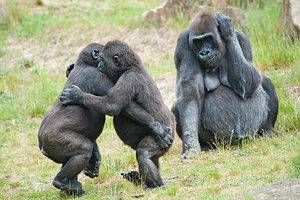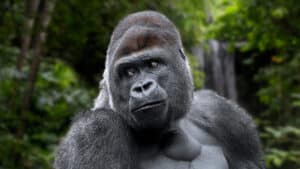Gorillas are beautiful and unique creatures. They are also incredibly large! Within this colossal animal is a very interesting and complex skull that seems to be very different from a human skull. In actuality, the skulls of our not-so-distant gorilla relatives are quite similar to ours. This article will investigate how our skulls compare and what other interesting information skulls can reveal about a species.
What is a gorilla?

A
western lowland gorilla
©Ltshears – Trisha M Shears / public domain – License
Gorillas are large land mammals that live primarily in Rwanda, the Congo, Uganda, Angola, Cameroon, Central Africa, Equatorial Guinea, Gabon, and Nigeria depending on the subspecies. There are two species of gorilla and four subspecies: western gorillas (including western lowland gorillas and Cross River gorillas) and eastern gorillas (including eastern lowland gorillas and mountain gorillas).
Gorillas belong to the order Primates. They are the largest primate on Earth and are also a member of the great apes. As such, they are closely related to orangutans, chimpanzees, bonobos, and humans. For more about the difference between apes and gorillas, click here. The lineage that includes chimpanzees and humans diverged from a common ancestor with gorillas about 12-17 million years ago. Considering the timeline of mammal evolution (with the first mammal arising 65 million years ago), this is quite recent! The close evolutionary histories of gorillas and humans explain many similarities that appear between the species.
What is unique about gorilla skull size?

A male
eastern lowland gorilla
©dptro/Shutterstock.com
Gorilla skulls are exceptionally large amongst primates. In fact, the average male gorilla’s skull is 16 cm high, 34 cm long, and 18 cm wide. Human skulls are 19 cm high, 15 cm long, and 18 cm wide. Skulls consist of the cranium (the brain case) and the splanchnocranium (the facial bones). The human cranium has a much larger volume than a gorilla’s cranium and houses a much larger brain. Gorilla brains are about 1/3 the size of human brains! A gorilla’s facial bones are much more robust than those of a human, however.
Gorillas are also sexually dimorphic. This is when there are distinct physical differences between males and females of the same species. Gorillas are very sexually dimorphic because male gorillas are much larger than females. Male gorillas typically weigh between 300 and 500 pounds, whereas females weigh between 150 to 250 pounds. As a result of this size difference, male gorilla skulls are much larger than female gorilla skulls.
What are some notable features?
{image: gorilla skull}
This table describes a few different features present on ape skulls and compares them in humans, chimpanzees, and gorillas. Each of these features can not only show us how the species differ from each other, but also about how they live. From these skull features we can learn about an animal’s diet, mating strategy, posture, and evolutionary history.
| Skull Feature | Sagittal crest | Prognathism | Foramen magnum position | Supraorbital ridge | Canine teeth | Mental eminence |
| Description | A bony crest on top of the skull | The degree to which the lower face protrudes forward | The hole at the base of the skull where the spinal cord exits | The brow ridge | The canine teeth (in humans, the third tooth over from center of teeth) | The chin |
| Humans | Absent | Absent | Anterior | Reduced | Reduced | Pronounced |
| Chimpanzees | Reduced | Reduced | Posterior | Intermediate | Intermediate | Absent |
| Gorillas | Pronounced | Pronounced | Posterior | Pronounced | Pronounced | Absent |
What do these features tell us?
Sagittal crest
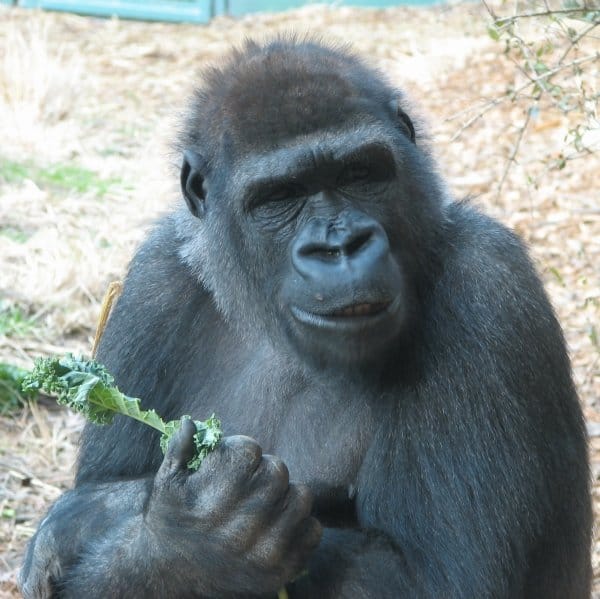
A mountain gorilla eating a leaf
©Ltshears – Public Domain
The sagittal crest is a bony ridge on top of some ape skulls that spans the cranium from front to back. By running your hand through your hair, you can pretty easily tell humans do not have one. In gorillas, however, the sagittal crest is an important muscle attachment site. The large sagittal crest indicates the attachment of large masticatory muscles (chewing muscles) capable of processing tough foods. Gorillas are folivores, meaning they rely mostly on foliage as a food source. Chewing a large volume of leaves requires strong chewing muscles and a skull that can withstand intense strain and bite forces. The gorilla skull has therefore evolved to support this diet and a large sagittal crest is the result.
Facial prognathism
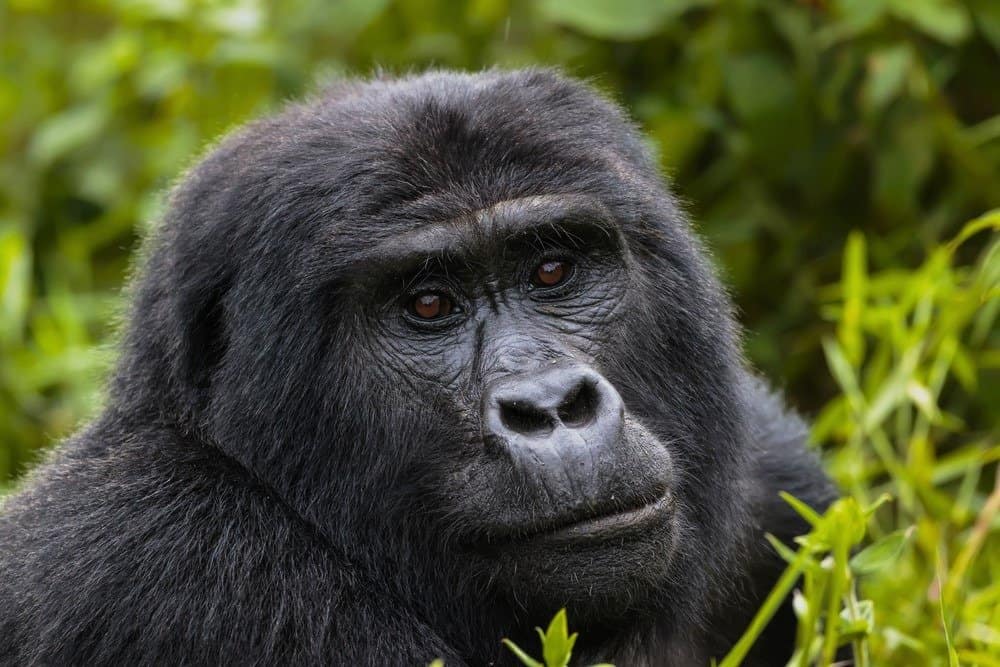
An eastern lowland gorilla
©Krasnova Ekaterina/Shutterstock.com
Prognathism describes the degree to which an animal’s lower face protrudes forward. There is a general trend of decreasing facial prognathism along the human evolutionary lineage. Generally speaking, Gorillas, who share a distant ancestor with humans 12-17 million years ago, have a high degree of facial prognathism. Chimpanzees, who share a more recent ancestor with humans 6-10 million years ago, have reduced prognathism. Human ancestor species predating the genus homo exhibit only a slight degree of prognathism.
Foramen magnum
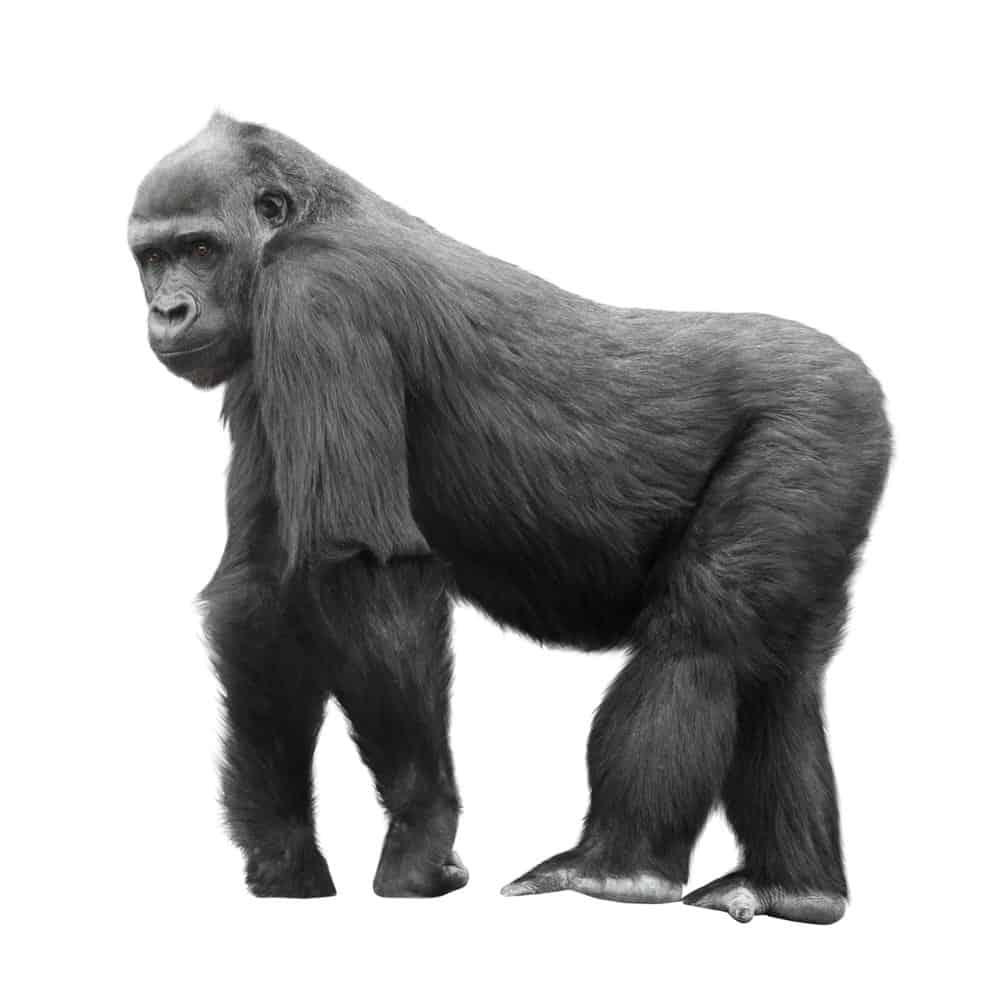
A mountain gorilla walking on four feet
©Roman Samokhin/Shutterstock.com
The foramen magnum is the hole at the base of a skull where the spinal cord exits. It’s position on primate skulls provides very important information that anthropologists use to understand existing species and fossil species. For example, in modern humans the foramen magnum is in an anterior (forward) position on the base of the skull. This trait evolved as ancient humans began walking on two feet (bipedalism). Bipedalism is a distinctly human trait amongst apes and is important to understanding human evolution.
When humans are standing upright, the anterior position of the foramen magnum allows us to hold our heads up and facing forward atop a vertical spine. A gorilla’s foramen magnum is towards the back of their skull, so they can face forward when walking on all fours with a more horizontal spine. By looking at the foramen magnum position of extinct and extant species, we learn more about the evolution of modern primates and humans.
Canine teeth
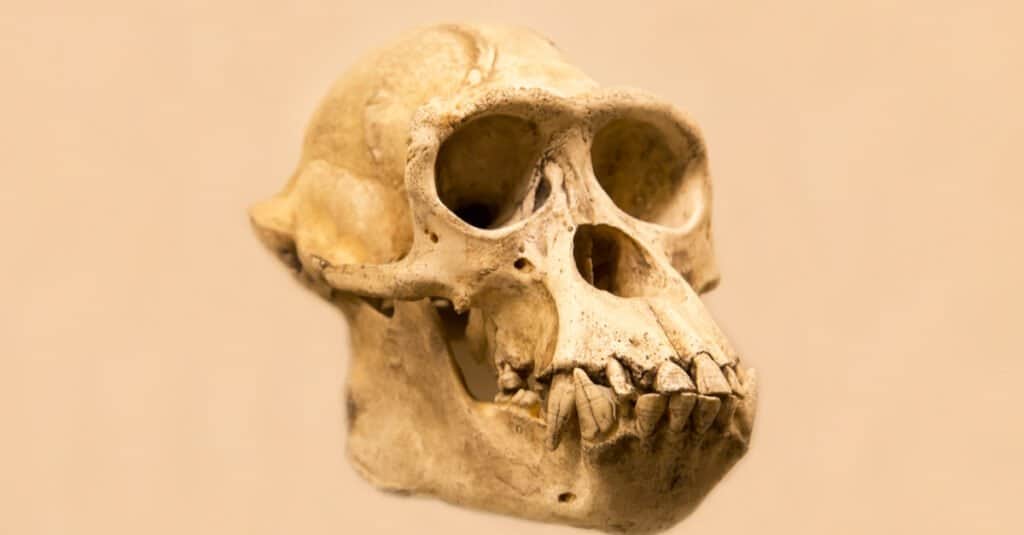
A chimpanzee skull with clearly visible canine teeth
©Victor1153/Shutterstock.com
The canine tooth is the third tooth over from the center in many primates. These teeth are an important feature of gorilla skulls that provide information about mating competition within the species. Many monkey and ape species with high degrees of sexual competition evolve large canines either for combative or intimidation purposes. For instance, in mandrills, only high-ranking males have access to females unless a subordinate challenges them. Large canines that will help attract mates and ward off other suitors therefore have a selective advantage in this species. So, a large-toothed male will have many large-toothed offspring and over many generations, large canines will become a common trait in the species.
Supraorbital ridge
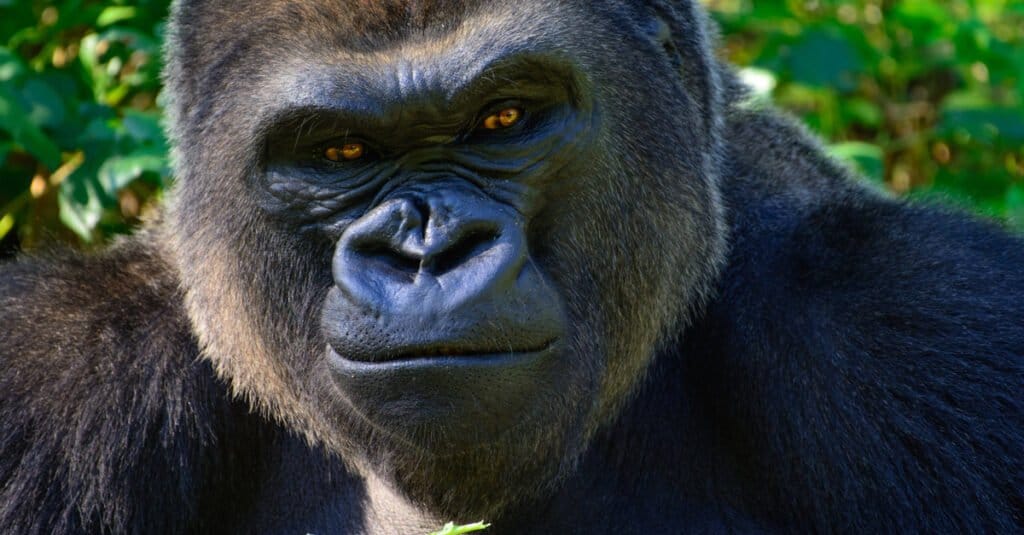
A mountain gorilla
©Jeff W. Jarrett/Shutterstock.com
The supraorbital ridge is the technical name for the brow ridge. Although modern humans have a very subtle brow ridge, gorillas have a very big one. This bone feature exists to mitigate stress from the jaw muscles and to protect the eyes. Gorillas retain this primitive feature in part due to its role in processing a fibrous diet, whereas humans have evolved weaker jaws and smaller chewing muscles over time. Thus, humans have a greatly reduced brow ridge.
How are gorillas doing today?
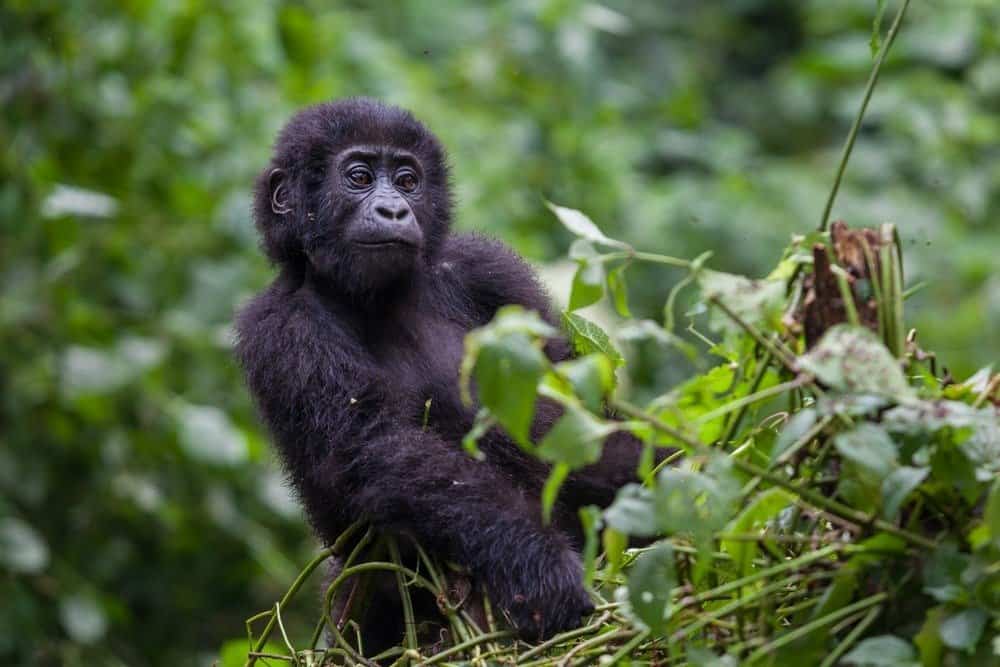
Baby eastern gorilla in Congo rainforest
©Katja Tsvetkova/Shutterstock.com
Both western gorillas and eastern gorillas are classified as critically endangered. This means the species are in immediate danger and near extinction. Habitat loss, hunting, and disease threaten gorillas most. Gorilla poaching is common for trophies and for the illegal meat trade in Africa despite local law. For example, the Gorilla Agreement prohibits the hunting and trading of gorillas and was implemented in 2008. The countries where gorillas live, however, are not capable of effectively enforcing these laws, leaving the gorillas vulnerable. Poachers, traders, and consumers of gorilla meat therefore continue to profit from hunting these critically endangered animals.
Gorillas are also threatened by human disease because of how closely related they are to humans. An Ebola outbreak in the Democratic Republic of the Congo in 2004 killed several hundred gorillas in Odzala National Park. A 2006 study later estimated as many as 5,000 gorillas in central Africa were killed by the Ebola virus. The deaths due to the virus have negative impacts on genetic diversity as well.
Efforts to counteract the decline of gorilla populations include captive breeding projects, ecological monitoring, and legal measures. In fact, efforts in zoos have supported the successful breeding of around 4,000 western gorillas. Additionally, the Great Apes Survival Project (GRASP) founded in 2001 aims to conserve non-human great apes including gorillas. GRASP puts an emphasis on the conservation of the natural habitats of great apes and has taken steps to remedy habitat loss.
The photo featured at the top of this post is © Philippe Clement/Shutterstock.com
Thank you for reading! Have some feedback for us? Contact the AZ Animals editorial team.




